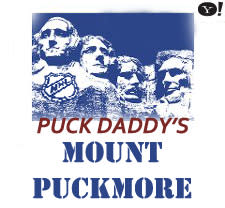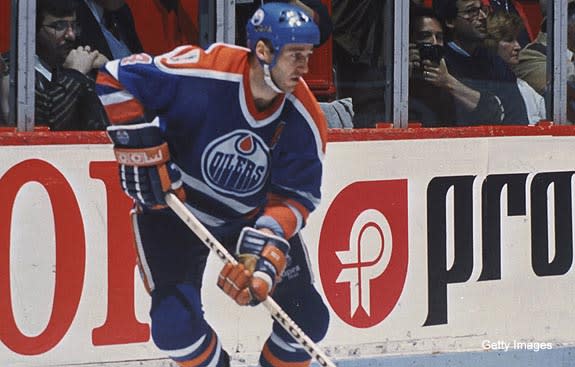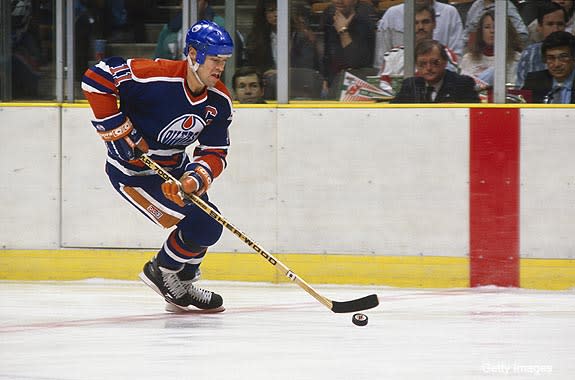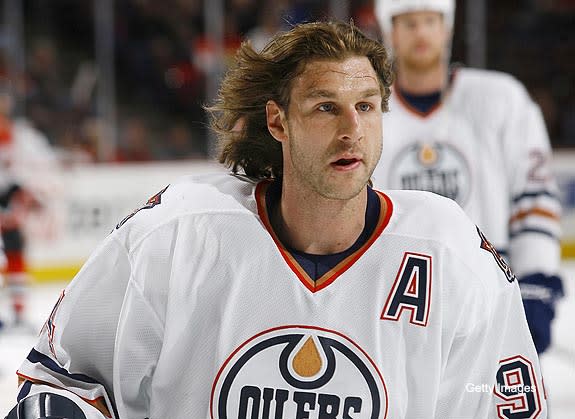Mount Puckmore: The four faces of the Edmonton Oilers

(Ed. Note: Welcome to Puck Daddy's August series,"Mount Puckmore" which will feature fans, bloggers and various media personalities of all 30 teams choosing the four defining faces of their franchise. These four people are who you remember most when you think of these teams -- whether they be players, coaches or executives. We'll be running these daily for the rest of the month. Today, representing the Edmonton Oilers, Bruce McCurdy of The Copper and Blue.)
By Bruce McCurdy
Four seems such an arbitrary number, doesn't it? It's hardly enough for a franchise which, since it came into the NHL in 1979, has won more Stanley Cups than any other. Hard to fathom that the fifth and last of those happened 20 years ago, the last blow on a mighty gong that still leaves its faint echo on the present.
It was an extraordinary squad, so quickly built yet sustained for over a decade before grounded by cash-strapped ownership, hamstrung management, lazy scouting, and simple economics. The strong temptation was to choose all four faces on the mountain from that one glorious spasm, with a couple Hall of Famers still to be named later.
Since the Oilers have more than enough players deserving to be chiselled in granite, I'm going to avoid the temptation to choose anybody from the suit-and-tie club. One could easily fill a second mountain (Buckmore?) with Wild Bill Hunter, Glen Sather, and Cal Nichols as Builders and Peter Pocklington having his own special category of Builder and Destroyer. Sather in particular was extremely difficult to leave out, given his central role in building and nurturing the Dynasty Oilers.
The distinction also needs to be made that this is the Oilers' Puckmore and not the Edmonton one. Otherwise I'd be (re-)making the Case for Randy Gregg, and strengthening the one for Sather, who was a great Edmonton Oil King way back in the early '60s. But I'll just stick to Oilers players of the NHL era.
How to choose, how to choose? We've got one automatic choice in the Great Gretzky, but I could make a case for each and all of the Magnificent Seven - Hall of Famers Mark Messier, Glenn Anderson, Jari Kurri, Grant Fuhr, and defensive stalwarts Kevin Lowe, Charlie Huddy, and Randy Gregg - who played on all five Stanley Cup winning squads. Paul Coffey, Esa Tikkanen and Craig MacTavish also earned heavy consideration. I decided to limit to two of those and leave one spot for a post-dynasty Oiler. The Little Team That Could had a face all its own, and again it will prove difficult to limit that to a single representative. But limit I must.
In both alphabetical and chronological order, here's Mount Puckmore, Edmonton edition ...
Wayne Gretzky, C
When the Oilers entered the NHL they were allowed to protect exactly one skater, but oh what a skater he was. How to distil Wayne Gretzky's legacy, his records, and his dominance into a few sentences?
Let's start with some numbers: Counting his year in the WHA, #99 played exactly 9.9 seasons in Edmonton. It was, by far, the most productive decade in the history of the sport, as he scored an astonishing 2051 regular season and playoff points for the Oilers. Think about that for a sec: <10 seasons, >2,000 points.
Traded/sold by Nelson Skalbania and the Indianapolis Racers to Pocklington's Oilers just 8 games into his pro career, Wayne debuted as a 17-year-old wunderkind, earning the Lou Kaplan Award as WHA rookie of the year - his first of 24 major individual awards he received as an Oiler. He led the perennial also-ran Oilers to a surprise first place finish and a berth in the Avco Cup Finals, finishing third in scoring with 110 points, then a league-leading 20 in the playoffs. It would be by far his worst season in Edmonton.

Gretzky thrilled the hockey world by tying Marcel Dionne for the scoring title as a teenager "in his first NHL season", leading the (so-called) expansionist Oilers to a shock playoff berth. His reaction to losing the Art Ross on a technicality - the Little Beaver had 2 more goals, the Kid 2 more assists - was both classy and classic: "My dad always taught me an assist is as good as a goal." The youngest player in the league was voted its MVP, as Wayne copped his first of an astonishing eight consecutive Hart Trophies.
The next year Gretzky left nothing to chance, winning his first Ross outright by a whopping 29 points, at the time an all-time NHL record for margin of victory. Not for long, mind, as the following 6 seasons the Great One beat the Ross runners-up by the mind-boggling margins of 65, 72, 79, 73, 74, and 75 points. Those nay-sayers who may want to discount Gretzky's (four!) 200-point seasons to "era effects" have yet to explain why the best of the rest were always so far in his wake, with the same ~130 points as the scoring champions of the ‘70s. Wayne's dominance was such that in 1986-87, the gap in the scoring race between first and second (linemate Jari Kurri) was greater than the gap between second and 200th!
As a season-ticket holder throughout those years, I was afraid to miss a game for fear of missing history. Gretzky may as well have hung out a shingle: "Genius At Work - Come Watch!" His hockey sense seemed ingrained at the molecular level. His ability to read the play and exploit time and space with his underrated physical gifts was unparalleled, and remains so to this day. He was quicksilver on ice, difficult to define, impossible to contain.
In his last year as an Oiler, #99 battled eye and knee injuries and was surpassed by Mario Lemieux for the Hart and Ross. He bounced back with a brilliant playoffs, winning his second Conn Smythe Trophy as the Oilers lost just two games in steamrolling to the Cup, their fourth in Wayne's five seasons as captain. The Gretzky Oilers remained in the ascendant, seemingly more invincible than ever.
And like that, poof, he was gone. Just 27, with years of his prime seemingly stretching in front of him. His Stanley Cup-winning goal that eliminated his old nemesis the Bruins, turned out to be Wayne's last as an Oiler. The dynasty had fallen victim to Peter Pocklington's cash flow problems.
Throughout his time in Edmonton Wayne drew the media spotlight the same way he drew defenders, and handled it very nearly perfectly right from the day he arrived in town as a pimply-faced 17-year-old. He was always as generous in his praise for teammates as he was with the puck, and they loved him for both. But above that he took his role as a national sports hero and role model very seriously indeed, seemingly doing all of the right things within the community. Along the way he taught damn nearly all of us a thing or two about consideration and respect for disabled people, especially the mentally handicapped. Wayne's influence in the organization can be felt to this day in the person of his great friend Joey Moss, a worthy Puckmore candidate in his own right.

Kevin Lowe, D
Kevin Lowe was no Gretzky when it came to talent, but made a lasting impression on the team from Day One right through to the present. Edmonton's first-ever NHL draft choice has been in the league ever since, a remarkable 31 years without a day in the minors. 27 of those years have been with the Oilers, whom he has served in the role of player, assistant captain, captain, assistant coach, head coach, general manager, and President of Hockey Operations. So in a limited way, I'm making an exception for my "no suits" rule, but will focus here strictly on K-Lowe's contributions as a player.
That said, Kevin looked good in a suit from the day he arrived. He was composed, thoughtful, well-spoken, and it was quickly apparent he would be a team leader both on and off the ice. His competitive fire was a constant each and every night, occasionally flaring into explosive bouts of temper that earned him the nickname "Vish" (for Vicious). Meanwhile, off the ice, he was a gentleman and a spokesman, especially in his home province of Quebec where his fluency in French put him in high demand. In early days Lowe and Gretzky shared an apartment and became close friends. They often did public appearances together such as the time they visited my wife's kindergarten class in Glenrose School Hospital and left a lasting, positive impression on more than just the kids. That whole group was highly visible in community involvement, and Kevin Lowe was one who embraced, even relished those obligations. It's fitting that his one major individual award was the King Clancy Memorial Trophy for leadership and humanitarian contribution.
Lowe was a "glue" player who adapted his game quite significantly to fit the Oilers' needs. A high-scoring blueliner in junior, he soon realized he was no Paul Coffey, but more importantly the team needed solid defensive players to support its awesome firepower. Kevin posted three straight 40-point seasons early in his career - not huge numbers on that team, but pretty good - but gradually evolved into a truly stay-at-home, shutdown defender. It seemed like Vish had a personal rivalry with every rugged right-winger in the Smythe Division, as he always seemed to line up against Lanny McDonald, Dave Taylor, Stan Smyl, Paul MacLean.
K-Lowe was one of those old-school guys who could withstand a physical pounding and keep on playing. His performance in the 1988 playoffs was the stuff of legend, as he wore a cast to protect a broken scaphoid bone - a particularly nasty injury for anybody who needs to handle a stick for a living - then played the last three rounds with broken ribs. You could tell by his reactions that he was hurting, but his robust style of play changed hardly at all.
Kevin served as team captain in 1991-92 after the mass exodus of Messier, Anderson, Fuhr, and Smith, and led the squad to a surprise Smythe Division crown, the last gasp of the dynasty Oilers. Dealt himself to the Rangers the following summer, he won one more Cup and several nice paydays in New York while the rudderless Oilers missed the playoffs four years running. In 1996 Sather signed Lowe as a free agent to bookend his career with the Oilers, specifically to mentor the next generation group, and the Oilers returned to the playoffs that season. Early the next, however, Kevin's career was ended by an inner-ear ailment.
Lowe played 15 seasons for the Oilers, and they made the playoffs all 15 years. He remains the Oilers career leader in both GP (1037) and playoff GP (161).

Mark Messier, C
Mark Messier was a local hero in every respect. The St. Albert native played his minor and junior hockey in the Capital Region, before jumping to the WHA as a 17-year-old, signed, ironically enough, by Skalbania to replace Gretzky. After an underwhelming one-goal season in the WHA, Oilers stole him in that same 1979 Entry Draft with their second-ever draft choice. Hard to believe Mark went 48th overall despite being the only 1961 baby in the draft, eligible only because he was already a professional. In fact he and Gretzky were the two youngest players in the NHL in 1979-80, after having shared the same distinction in the WHA the year previous.
Messier came to his first Oiler camp as an unbroken, frisky colt. His prodigious talent was on display right from the start - a fabulous physical specimen with hands of silk, elbows of steel. And most importantly, wings on his feet. That boy could flat-out fly.
It took a couple years to rein in that talent and the young man who embodied it. Messier was perhaps Sather's biggest challenge, the only one of the superstars ever to be sent to the minors. As if to prove to him how things could go off the rails, Mark's cousin Don Murdoch was brought in, then unceremoniously shipped out. Messier's game ranged erratically from brutal to brilliant, often within a single shift, but the speed, skill, and desire were there for all to see. All too often, though, his brain was left in his wake; I used to kid that he led the league in rookie mistakes every year.
Midway through his second NHL season Messier was teamed with fellow youngster/speedster/competitor Glenn Anderson on a regular basis, and they quickly became a fearsome attacking duo. A year later Mark exploded with 50 goals and made the NHL First All-Star team at LW. Not coincidentally the Oilers soared to 417 goals and became a full-fledged contender. The coveted second scoring line had emerged, right out of the middle rounds of the 1979 Entry Draft.
Sather saved his master stroke for late in the 1983-84 season, when he moved his All-Star LW into the middle. Messier responded like a champ, and the effect was transformative. The Oilers won their first Cup that spring, with Mark himself being a surprise Conn Smythe winner thanks to a dominant Finals against the Islanders.
In the five years that Sather ran with a Gretzky-Messier duo at centre, the Oilers posted a playoff record of 68-18 with 17 series victories and a single fluke defeat. There was no doubt that Messier was the #2 man on that particular totem pole, but when the Great One moved on to Los Angeles he was more than ready for his promotion to the first line, to the captaincy, to becoming the Face of the Oilers.
Mark enjoyed his greatest season in 1989-90, when he came second in regular season scoring (behind Wayne, natch), then led the playoffs in both scoring and determination as the Oilers rolled to a shock fifth, Gretzkyless Cup. He received the Hart Trophy, and was named First All-Star centre, thus becoming the only player in NHL history to be an All-Star at two different positions.
Messier's time with the Oilers was soon to be done, shipped east like the others to receive retirement contracts from Greener pastures. Turned out Mark was barely halfway through his career, ultimately playing right up to the lockout. He holds the NHL record for career Games Played, combined regular season and playoffs (1992), and is second on a whole bunch of career achievement lists, including regular- and post-season points. In fact he's the only NHLer within 1000 regular season points of his old pal Wayne Gretzky.
That a big part of Messier's huge heart still rests in his hometown was affirmed in 2004, when Mark joined the rest of Boys in the Bus in the Heritage Classic despite the complication that he was still an active player at the time! Hard to know what went on behind the scenes but my read was that Mark simply told the Rangers and the NHL what he was going to do, and that was the end of the discussion. By that point there was nobody in hockey willing to get in Mark Messier's way. Besides, it was the right thing to do: no gathering of the dynasty Oilers would have been complete without him. Mark was the last surviving player of the old World Hockey Association, just as the Oilers were the Rebel League's only surviving team.

Ryan Smyth came to the Oilers with a weird connection to the dynasty club: as a kid he had been run over by Glenn Anderson!
Team Canada was training for the 1987 Canada Cup in Smyth's home town of Banff, and young Ryan managed to snag a job as a stick boy. Bruised but unfazed when Anderson accidentally backed over him in the parking lot, Smyth remained a diehard Oiler fan who to some extent patterned his game after Anderson's fearless style.
Seven years later, in '94, Smyth would become an Oiler, a hot prospect claimed with the 6th overall draft pick. There was nothing pretty about Smytty: neither his face, nor his playing style, nor his goals. He was just a homely boy-next-door type who couldn't help but win you over with his dogged play in the slot, along the boards, and at the edge of the crease. His enthusiasm for invading the tough areas of the ice was evident right off the hop, and infectious.
Smyth made one of the most dramatic single-season improvements I've ever seen, surging from just 2 goals in his rookie season to a career-high 39 his sophomore year. He would soon settle down to a level somewhere in between the two, eventually posting three more 30-plus goal seasons much later in his Oiler career.
To fully appreciate Ryan you had to watch him over the long term: grinding, grinding, grinding, working the puck out of one zone and into the other, night after night, year after year. Along the way he played with some mighty fine players, including Doug Weight(notes), Todd Marchant(notes), Mike Grier(notes), Curtis Joseph(notes), Jason Smith, Ales Hemsky(notes), Shawn Horcoff(notes) ... of them only Smyth played right through the era of the Little Team That Could (1996-2006) and in my mind is the best candidate to represent that group on Puckmore.
The Mullet Man with the aw shucks attitude became a fan favourite around the NHL. Even people who hated the Oilers couldn't say much bad about the guy, and folks in this country always seemed happy to see him throw on his red and white cape and magically transform into Captain Canada. While all of the Puckmore Oilers have had a lengthy and successful relationship with Hockey Canada, Ryan Smyth leads the way with five gold medals - a World Junior, an Olympics, two World Seniors, and a World Cup - all won while he was property of the Oilers.
In 2006 Smyth came within an ace of completing the Grand Slam, as his Oilers made it to the seventh game of the Stanley Cup Finals before losing in heartbreaking fashion to the Ghost of the New England Whalers. The Face of the Oilers got a little uglier in that playoff run, as Smyth famously took a Chris Pronger(notes) clearing shot right in the gob, spit out a few chiclets, stayed in the game and eventually - about four hours later! - set up the game winner in triple overtime.
But that was Smytty. Nobody would have expected anything different but hockey the old-fashioned, Canadian way.
Smyth would be traded from the Oilers the next spring in an extremely controversial deal, like all the Puckmore Oilers it seems. As Sather had once traded Lowe to the Big Apple in search of a retirement contract, so did Lowe trade Smyth to New York 15 years later. Many tears were shed, and not just by Cryin' Ryan; a large segment of the fanbase was heartbroken.
The faceless team Smytty left behind crashed and burned, and to a large degree still hasn't found its way. Fortunately, the Oilers finally have a few fresh-faced Puckmore candidates to lead the next wave. Let's have this conversation again in a decade or two.


